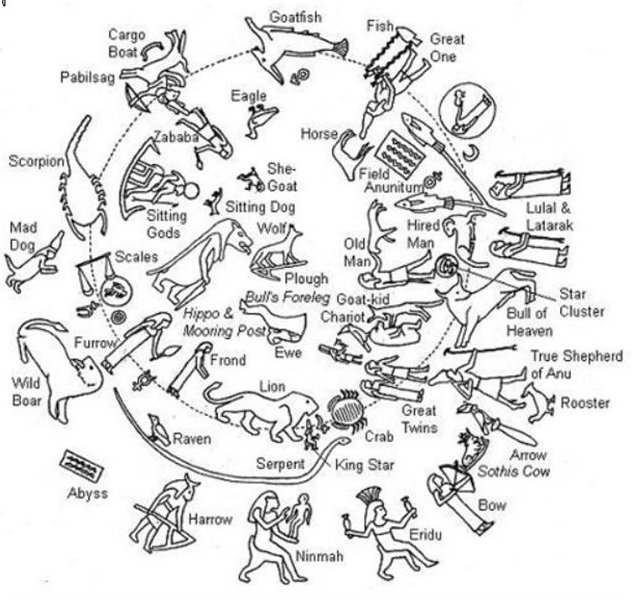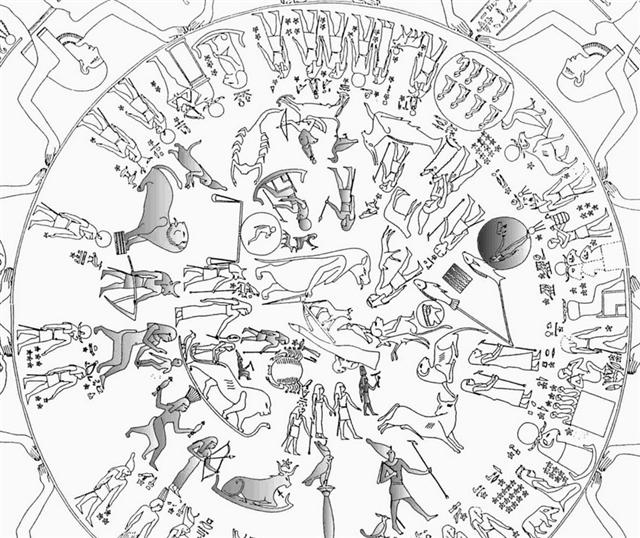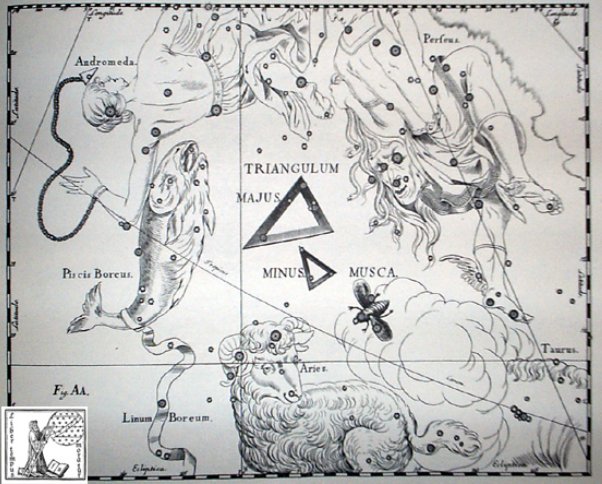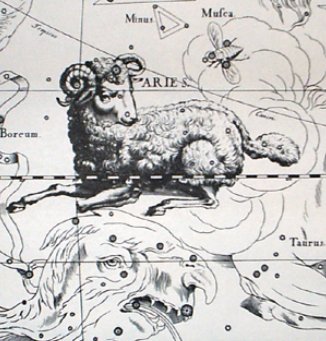In this creative interpretation of the Dendera round zodiac the Wedjat Eye has been relocated to a position above the Head of the Taurus Bull:
The Star Cluster in question surely has to be the Pleiades. Although not indicated in the Dendera round zodiac we can find the stars of the Pleiades in the corresponding place in the Babylonian zodiac:
The Bharani Fly (Musca Borealis) above Aries was equivalent to the Pleiades Cluster above Taurus. These asterisms had the same basic meaning, one of them arriving before the rainy Hyades clouds and the other after:
Although there were 14 precessional days from May 1 (121) to April 17 (107) instead of the ancient 13 precessional days from May 28 (148) to May 15 (135) - counted by moving backwards among the heliacal stars and up towards the present.
The ancient single star child was Aldebaran, the Red one, in contrast to the younger twin stars Sheratan and Mesarthim, alias the single wife of the Ashvins (Horse Men). 13 represented the Sun and 14 the Moon (which had to be counted twice - Waxing and Waning). Therefore Aldebaran ought to have been a Sun child in contrast to the Twins generated by Musca Borealis. Aries was a ewe uplifted from the waters on the head of Cetus:
From these reflections of mine we can identify the time at the end of side b on the G tablet as a time before the Sun child had been born - by using the ancient frame of time-space according to Taurus. Aldebaran and Sheratan were similar but not the same, and there were 41 precessional days from the ancient one to the younger off-spring. 41 Tauri is the Bayer designation for the star Bharani and 41 precession days was the distance from 0h at the time of rongorongo down to the time when Bharani rose with the Sun at 0h.
Henua in Ga1-3 is similar to but not the same as henua in Gb7-24, and the rising fish (vaha mea) 27 days after March 21 was not the same as vaha mea at Aldebaran. There was gold at the beginning of side a but silver at the end of side b. The importance of Bharani should not be underestimated and in rongorongo times 41 Tauri rose 41.4 days after 0h (March 21). This number is not coincidental - it was meant to point at the time of birth of the Moon cycle:
I have used the Arab structure to arrive at 0h at the time of rongorongo, because I had found the fraction .4 was decisive (but only up to the end of Leo):
Logic implies the path of the Sun went ahead among the constellations, whereas the path of the Moon went withershins, therefore the Mothers of the Sun baby - the Nurses of Kārttikeya - had to be earlier in the text, whereas the Mother of the Sheratain twins (Bharani) had to be later in the text. Puo (covered) in Gb8-8 (alluding to 8 * 8 = 64) was exactly the same as puo in Gb8-30:
The position of 41 Tauri was not only similar to but the same as that of Alcyone and Atlas - viz. a place for birth. ... We have already ... attempted to explain the striking phenomenon that the Bull and Pegasus, both with half-bodies only, ήμίτομοι, enclose the Ram between them, by the assumption that the latter was interposed later, when the sun at the time of the vernal equinox was in the hind parts of the Bull, so that this point was no longer sufficiently marked in the sky. Another matter susceptible of a like explanation may be noted in the region of the sky opposite to the Ram and the Bull. Although we cannot doubt the existence of an eastern balance, still ... the Greeks have often called it χηλα`ι 'claws' (of the Scorpion), and according to what has been said above ... the sign for a constellation in the neighbourhood of our Libra reads in the Arsacid inscription 'claw(s)' of the Scorpion. These facts are very simply explained on the supposition that the Scorpion originally extended into the region of the Balance, and that originally α and β Librę represented the 'horns' of the Scorpion, but later on, when the autumnal equinox coincided with them, the term Balance was applied to them ... (Peter Jensen, Die Kosmologie der Babylonier, according to J. Norman Lockyer, The Dawn of Astronomy.) ... If my suggestion be admitted that the Babylonians dealt not with the daily fight but with the yearly fight between light and darkness - that is, the antithesis between day and night was expanded into the antithesis between the summer and the winter halves of the year - then it is clear that at the vernal equinox Scorpio setting in the west could be watching the sunrise; at the autumnal equinox rising in the east, it would be watching the sunset; one part would be visible in the sky, the other would be below the horizon in the celestial waters. If this be so, all obscurity disappears, and we have merely a very beautiful statement of a fact, from which we learn that the time to which the fact applied was about 3000 B.C., if the sun were then near the Pleiades ... (Lockyer) ... In ancient Egypt the sun was illustrated (and thought of) as several different 'persons', defined by its phase. As Lockyer summarized it: Hor, or Horus, or Harpocrates, and Chepera (morning sun) Rā (noon) Tum or Atmu (evening sun) Osiris (sun when set) Lockyer also reached the conclusion that it was the relation between a celestial object and the horizon which defined it and gave name to it: '... Then, there is also the matter of the horizon as 'measurement staff' and its functional names for celestial objects. The fundamental truth that Lockyer here has found is that in the ancient world the identity of a celestial object (or of anything) is of no importance, what matters is instead relations ...' In this frame of reference Horus = 'sun, planet, or constellation rising', Isis = 'anything luminous to the eastward heralding sunrise', and Osiris = 'any celestial body becoming invisible' ...
|
||||||||||||||||||||||||||||||||||||||||||||||||||||||||||||||||||||||||||||||||||||||||||||||||||||||||||||||||||||||||||||||||||||||||||||||||||||||||||||||||||||||||||||||||||||||||||||||||||||||||||||||||||||||||||||||||||||||||||||||||||||||||||||||||||||||||||||||||||||||||||||||||||||||||||||||||||||||||||||||||||||||||||||||||||||||||||||||||||||||||||||||||||||||||||||||||||||||||||||||||||||||||||||||||||||














